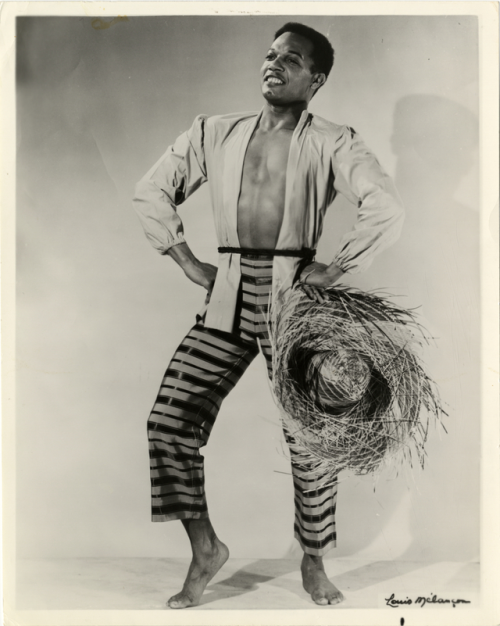
First, some plain old links. The estimable Marc Myers, author (most recently) of Why Jazz Happened and custodian of JazzWax, one of my daily destinations in the jazz blogosphere, yesterday wrote about Jamaica Jazz, the 1957 album of tunes from the Harold Arlen-Yip Harburg Broadway musical Jamaica, arranged for the Don Elliott Octet by the great Gil Evans. (I myself made a passing and unfairly dismissive reference to the disc a year ago; see “Le Jazz Primitif.”) The show, which, as Myers describes it, depicts a small Caribbean island “trying to keep from being overrun by American commercial interests,” was primed if not exactly provoked by the Calypso Craze of that same year—Belafonte was originally meant to play the lead role, in fact—and it featured Lena Horne, Ricardo Montalban, and Josephine Premice, the subject of my previous post, singing some saucily calypsoesque tunes. (Trying to keep from being overrun by American commercial interests, eh? Good luck with that.) Myers, whose blog is often browser-challengingly photo-heavy, includes a lovely shot of Premice with co-star Ossie Davis.
Next, some genuine reblogging, also about calypso and jazz and the ironies of cultural imperialism. Over the weekend, Lisa Paravisini’s indispensable Caribbean culture aggre-blog Repeating Islands re-posted John Cline’s LARB review of Laura Putnam’s new book, Radical Moves: Caribbean Migrants and the Politics of Race in the Jazz Age. Putnam focuses on the “counterpublics” of the circum-Caribbean, particulary West Indians working abroad in Central America and their role in catalyzing the anti-colonial movements of the 1930s, 40s, and 50s. (Lest we think globalization is only about the inexorable triumph of Western capitalism.) For my part, I’ll just repeat a couple of key paragraphs from Cline’s review:
In chapters on the black press and music within the circum-Caribbean, Putnam extends her earlier point about the “forgotten editors of port-town newspapers” to conclude that:
As British Caribbean migrants spread outward, they linked local publishing with Atlantic- and empire-wide media circuits to create an internationally connected black press, newspapers densely woven into community life but looking out across the globe.
A rift existed between those editors and the young “regge” dancers [of Port Limón, Costa Rica], a conflict between the “high” and the “low” culture of the imagined community. But it is through both these discourses that circum-Caribbean counterpublics were linked to the rest of the Black Atlantic. Newspapers in Port Limón, Costa Rica, and Panama frequently republished articles from newspapers like The Chicago Defender within days of their initial publication. (United Fruit’s fleet of boats was certainly useful in this regard.) Without this media network and its political concerns, it’s difficult to imagine how the crowning of Ras Tafari as Haile Selassie I could have been transmuted into religious beliefs among poor, rural Jamaicans. Putnam, too, makes a convincing argument that “jazz” and the “Jazz Age” was the result of more than just New Orleans, Chicago, and Harlem. In particular, she astutely observes that while few jazz musicians in Harlem were West Indians, the owners and managers of the venues they played frequently were — as was their audience, which constituted a significant portion of Harlem’s black population in the 1920s and 1930s. Through the same networks that brought occultism and black newspapers from the United States to the circum-Caribbean, traveling US jazz musicians had a significant impact on the development of later West Indian music, from Trinidadian calypso to Jamaican ska. Although Radical Moves only infrequently touches on West Indian immigration to New York, Putnam does mention the calypsonian Wilmoth Houdini, whose colleagues included the Duke of Iron and a son of Caribbean immigrants calling himself “The Charmer,” better known today as Louis Farrakhan. Houdini’s 1939 “He Had It Coming” was rearranged by Louis Jordan as “Stone Cold Dead in the Market,” sung by Ella Fitzgerald in 1946. This single initiated a run of five #1 R&B singles in a row for Jordan, a feat never since repeated. “Stone Cold Dead in the Market” and its fellows “Choo Choo Ch’Boogie” and “Ain’t Nobody Here But Us Chickens” are key moments in the transition from big band to rock ‘n’ roll, revealing a Caribbean ancestry within that most “American” of musics.
And then, in the spirit of solipsistic self-referentiality that animates the web, I’ll point you back to some of my own thoughts on jazz and calypso as popular musics in 1940s New York. Lather, rinse, repeat.





